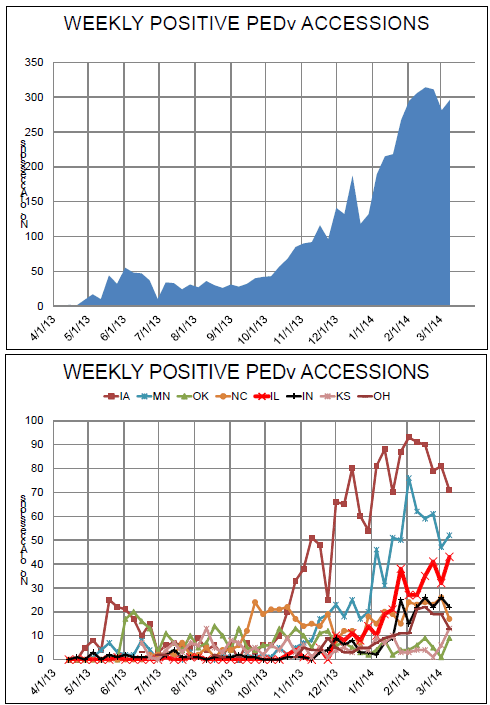



CME: Analysts Anticipate Numbers in Upcoming Hogs & Pigs Report
US - Analysts and market participants will be spending a good amount of time over the next week estimating and anticipating the numbers in USDA’s quarterly "Hogs and Pigs" report which will be released on Friday 28 March, write Steve Meyer and Len Steiner.The Daily Livestock Report will have the results of Urner Barry’s pre-report survey of analysts next week but we thought it might be helpful to review what has happened so far as an input to readers thinking and decision making over the next few days.
Porcine epidemic diarrhea virus (PEDv) is a coronavirus that had never been observed in the US until last spring. It is closely related to the coronavirus that causes transmissible gastroenteritis (TGE), a disease that was once a major scourge of the pig industry but which has been seen far less frequently since a large portion of US pigs were moved indoors thus separating them from birds which were a major TGE vector. TGE appears from time to time but it no longer a serious threat.
The first identified PEDv case was in Iowa in May. Subsequent testing of historical samples at diagnostic laboratories identified a case in Ohio in April. The first identified virus was 99 per cent genetically identical to a strain found in China in 2010. Two other PEDv strains have been identified since then. Both are about 94 per cent genetically similar to the Chinese strain. According to Dr. Derald Holtkamp of Iowa State University, the degree of difference suggests that these are separate introductions, not mutations. A third additional, and new, virus (now called deltacoronovirus) has also been identified. It is less virulent than the PEDv strains.

The virus is deadly for suckling pigs with losses of 100 per cent common for animals under 3 weeks of age. Death loss and morbidity are low for older growing pigs and for sows. This is noteworthy in its implication for market impact: PEDv losses will not be seen in slaughter totals until about 6 months after an individual herd breaks. Being a virus, there is no direct treatment for the disease once it appears. Since no preventive vaccine is yet available, the only way to fight the disease at present is to feed infected tissue or feces back to yet-uninfected animals in order to make them sick and stimulate an immune response. Immune sows then provide antibodies to subsequently-born baby pigs through the colostrum they produce in the first few days after birth. Feedback is not a pretty process but it is all that has been available.
PEDv is not a reportable disease under federal animal disease regulations. That status has historically been reserved for OIE (the international animal health organization) programme diseases such as hoof and mouth disease, classical swine fever and African swine fever that will directly impact exports and imports. Pseudorabies was also made reportable during the eradication programme of the 1980s and 1990s. Since PEDv was not reportable, data on its location, spread and severity has been rather piecemeal. The National Animal Health Laboratory Network publishes weekly data by state. Its report can be found at www.aasv.org.
PEDV, like viruses in general, survives very well outside a host animal in cold temperatures. Veterinarians warned the industry last summer than winter temperatures could make this virus very difficult to control and that warning has proved correct. Conversely, warmer temps will slow PEDv’s spread, especially as producers learn better treatments and ratchet up biosecurity systems. Recent weekly accession data are hopefully confirming this expectation.
So how might this play out next week? The big impact will likely be on the Dec-Feb pig crop and the under-50 and 50-119 pound market hog categories since roughly 60 per cent of the total PEDv accessions for all hogs and for suckling pigs have occurred since 1 December. As for the breeding herd, unprecedented profit potential would normally drive expansion but producers are VERY preoccupied with the disease. They may not want more sows any time soon given how much trouble they have had with the ones they already own. Further, PEDv has hit some genetic multiplier units making gilts less available for expansion. PEDv-immune sows have some real value at present meaning they are more likely to be retained. That fact has contributed to nearly 7 per cent lower sow slaughter year-to-date. Euthanization of pigs at early ages has disrupted normal re-breeding schedules and could have some impact on the levels and timing of farrowing intentions this spring and summer.








